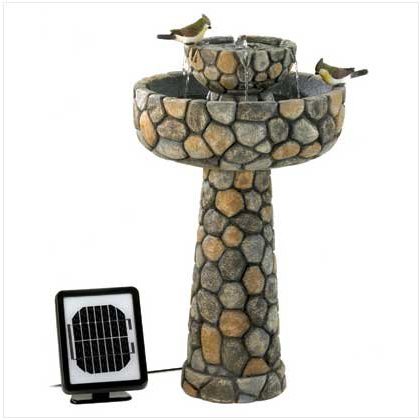
Bird Baths - Which Kind Should I Get?
Bird baths are a great way to attract birds to your yard and can be a decorative addition to your landscape.
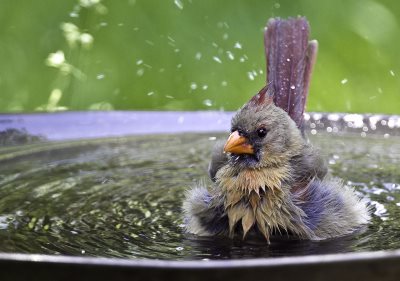
The number and diversity of birds visiting will increase and they will spend more time in your yard since they don't have to go searching for water elsewhere.
Birds that don't visit your feeders, may come to your water basin. Robins, waxwings, wrens, swallows, bluebirds, other insect or fruit-eating species won't come to your seed feeders, but will appreciate a nice cool drink and bath.
Buying Guide and Tips for Bird Baths
- Size: Bigger, wider, multiple tiers will attract more birds but will take more time and effort to keep clean.
- Depth: No deeper than 2-4 inches (8-10cm), preferably shallower at edges, with a gradual slope. Most birds don't like bathing in water above breast height.
- Bottom Surface: Should be textured or rough. Slick, slippery bottoms
make birds uncomfortable just like we do walking on a wet pool bottom with bare
feet.
If you purchase a bath or fountain with a smooth bottom, you can rough it up with coarse sandpaper, fill it with natural pebbles/stones/rocks or other non-skid applications. - Placement: Away from predators. In most neighborhoods, the greatest threat is cats, dogs and raccoons.
 Keeping it elevated will also keep these animals and others from drinking
the water and making it dirty before the birds even get to it. If the bird bath isn't already on a pedestal, raise it up as high off the ground as you can. Also keep it away from thick cover where
predators can hide.
Keeping it elevated will also keep these animals and others from drinking
the water and making it dirty before the birds even get to it. If the bird bath isn't already on a pedestal, raise it up as high off the ground as you can. Also keep it away from thick cover where
predators can hide.
Next to or under a tree is ideal. The tree can provide shade to keep the water cooler and birds will have a place to perch when coming to or leaving the bath. - Sound: Moving. trickling water, like a babbling brook, stream or river attracts birds more so than
silent, stagnant water.
You can get a fountain with built-in pumps, even solar-powered, or create your own drip/trickle into the fountain with a dripper that attaches to a hose or hang a container above the bath and pierce tiny holes that will slowly drip into the bath throughout the day.
You can line the container with cloth or something similar to slow down the dripping. - Hummingbirds: Although not common, I've
seen hummingbirds dip in and out of a small brook to bathe.
They will visit your bath, but will especially appreciate a mister that they can fly through.
Being so small, they rather fly through a mist then get into a pool of water which makes them more vulnerable to predators.
How To Clean A Bird Bath
- Refill and Cleaning: Make sure you place your bath close enough so that it can be easily refilled and cleaned out with a hose. On hot days, refill at least once a day.
Use a wire brush to scrub out
any accumulated dirt or algae.
To keep your water clean in bird baths with fountain pumps and clear and free of algae build-up there is a product called EasyCare FounTec Algaecide and Clarifier.It's safe for birds, plants and animals (but not fish) and easy to use.
One dose every 2 weeks during the summer, then once every four weeks during the rest of the year.
If nothing else, make sure you at least exchange stagnant water out with fresh and remove dirt, debris and algae. Otherwise, the birds are better off without your bird bath if it is not kept clean.
A Heated Bird Bath Provides Water For Birds During Winter
Having a heated bird bath is a must if you want to provide birds with a reliable water supply during the cold, winter months and you don't enjoy constantly having to do it manually by breaking ice and delivering warm water every few hours.
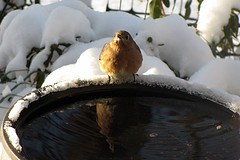
We have researched and found some heated bird bath favorites among backyard bird watchers.
Favorite Lower-Priced Heated Bird Bath
Many backyard birdwatchers like the API 600 20-Inch Diameter Heated Bird Bath Bowl.
It's a large basin so you don't have to fill it up as much because of evaporation which also makes it more difficult to freeze. Comes with various brackets to attach to decks, railings, etc..
It's under $50, is thermostatically controlled which means it heats only when
the temperature falls below freezing, will keeps the water ice free to -20�F
(but some customers have testified to it working below -35 degrees), hidden
cord, powder-coated and easy to install. The tray is easy to lift up the basin and dump the water out and clean. It is
shallow and depending on how cold it is, humidity levels and how many birds you
have visiting, you may have to refill it anywhere from twice a week to twice a
day. But most users have not found it to be too much of an nuisance and prefer
this bird bath over others. The cord is a little short, so you may have to use
an outdoor-rated extension cord depending on the location and distance from your
outlet.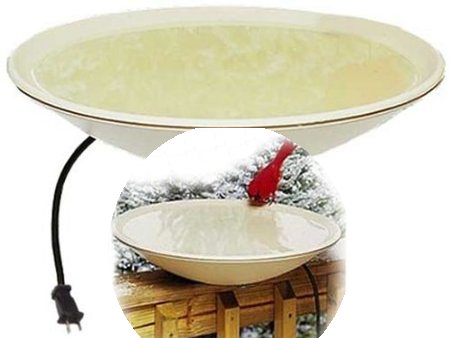
2nd Favorite Low-Cost Heated Bird Bath
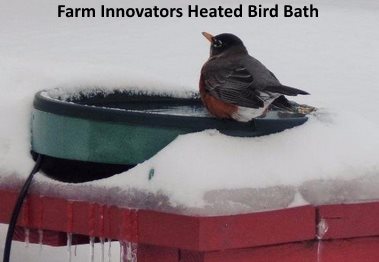 For
another of the lower priced models, we like the
Farm Innovators BD-60 75-Watt Bird Bath which comes with your choice of
either a clamp mount, deck mount or ground mount.
For
another of the lower priced models, we like the
Farm Innovators BD-60 75-Watt Bird Bath which comes with your choice of
either a clamp mount, deck mount or ground mount. More Expensive Heated Bird Baths
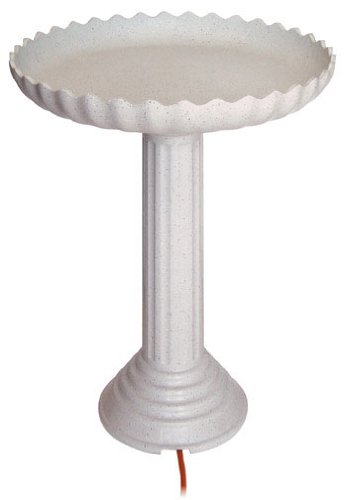
For the higher-end models, this Pedestal Heated Birdbath with Scalloped Dish Design is well-made, very sturdy and will hold up to stormy winter conditions.
As opposed to the cheaper Farm Innovators bird bath which uses 75-Watts, this one uses double the amount of electricity at 120-Watts. But it is a bigger basin at 17.5" diameter versus 15" which hold more water, requiring more heat.
Most users have found that the models shown above are reliable and will keep your bird bath water ice-free under freezing conditions. So depending on what your needs are, you can choose either a mounted bowl style or one with a pedestal.
Heated Bird Bath Features To Look For:
- Controlled By Thermostat - So it only turns on when needed, saving electricity.
- Corrosion Resistant - Powder coated or rust-free construction.
- Rated to -20 degrees F - Or lower which will keep water from freezing in most northern climates, with the exception perhaps of parts of Alaska, Canada, Greenland, North Pole, etc.. :-)
- Hidden Cord - Or one that can be tucked away, especially during the summer when not using; not necessary but nice to have.
What About A Solar Heated Bird Bath?
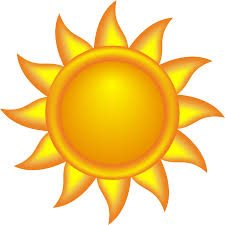
We have not found a reliable solar heated bird bath on the market yet.
The closest product is the Solar Sipper which people have found to be poorly designed, does not keep the water consistently ice-free and birds don't readily use it because of the covered top. It's not much more than an insulated cup.
There are plenty of solar powered bird baths and solar inserts to power a pump, but nothing yet to de-ice water.
Solar panels are expensive and the challenge of less sunlight during winter months apparently makes this a challenge for manufacturers.
Perhaps a better solution would be a wind-powered heated bird bath because it's easier to harvest wind power during winter than solar. We're still looking for a better one and will report here when we find it.
Stone Bird Baths
Stone bird baths typically come in two styles: basin and fountain.
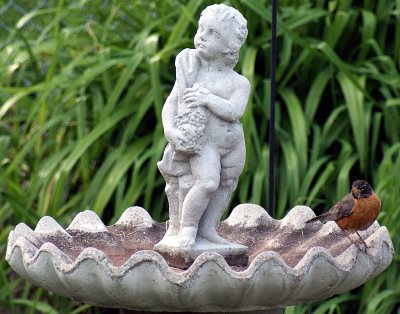
The fountain design with water pump may have one to several tiers for bird to drink and perch from and sometimes a decorative finial which is the top piece where the water exits.
Some bird baths may also have lights, but this is more for your own enjoyment, as most birds will not be coming to your bird bath in the dark.
For high quality baths, price range typically is anywhere from $50 to over $1,000.
Most are hand-crafted, cast stone construction with a variety of finishes to choose from such as aged limestone and copper-bronze or a natural finish, if you prefer.
Get a bird bath with a basin that can accommodate more than just a couple of birds at a time, that is if you want to see more birds at any one time using the bath.
If the basin's depth is deep enough for larger birds to use, but too deep for smaller birds, you can place a flat rock or something similar in the middle to make it shallower.
Winterizing Stone Bird Baths
Manufacturers suggest that stone bird baths ideally should be moved inside during the winter, or at the very least, be winterized to prevent cracking and other damage.

Water should be drained and the bird bath be raised to keep from freezing to the ground.
Any pumps and related mechanisms should be removed and stored inside.
You can cover the bird bath/fountain with burlap (or any absorbent material) and dark plastic which will keep moisture out and protect it from the harsh winter elements.
Solar Bird Baths

Solar bird baths are a great alternative to standard electric bird baths or the simple you-fill, standing water bird baths.
They save electricity which is good for the environment and your wallet and provide clean, running water that attracts more birds.
Below are some favorite bird baths and fountains among bird watchers.
The only disadvantages of a solar vs. an electric powered bath or fountain is that it requires direct sunlight and may not be as powerful, however it is less noisy, more peaceful and for those reasons is preferred.
For those of you who live in not so sunny climes i.e., Seattle, there are solar bird baths that have both solar and electric options so on cloudy days, you can just have it plugged in if there isn't enough sunlight to power it...
See the Wishing Well Bath below.
Advantages of Solar Bird Baths:
- Uses the sun's energy instead of electricity - Ecofriendly and saves money
- No extension cords or outlets needed - not limited to placement
- No wiring, no operating costs, simply install, add water and enjoy!
How does a solar bird bath work?
A solar powered panel that either is placed inside the basin of the bird bath or a panel that lays just outside the baths collects solar energy from the sun during the day.
That energy will power the pump to keep the bird bath water circulated.
Some solar powered bird baths can be damaged by cold weather, so during the winter months you may need to remove the solar insert and/or use it in conjunction with a bird bath heater that keeps the water and unit warm.
Again, on cloudy days, there are those units that also feature an electric option for plug-in power like the one featured below.
Solar Bird Bath with Optional Electrical Plug-In on Cloudy Days
The Wishing Well Solar Water Fountain is a nice choice because you have the electric option on cloudy days.
DIY Bird Bath Fountain using a Solar Panel and Pump Kit
Alternatively, you can use an existing bird bath - or really any type of basin - and convert it into a solar bird bath fountain by just using an inexpensive ($15-$40) solar panel and pump kit.
Watch the video below for this DIY option.
Q: Is It Safe to Spray Paint My Bird Bath?
A: Yes, you can spray paint your birdbath. But do not use any spray paints that are oil or petroleum based.
Make sure the bird bath is completely dry before painting. You should apply at least 2 coats, allowing each application to dry before applying another.
Krylon-brand spray paints, among others, are non-toxic when dry. Use a clear coat spray paint as the final coat to act as a sealer.
You basically want an attractive design that blends into the landscape, attracts birds, is easy to install and is sturdy enough to hold up to any weather elements and not be easily knocked over.
Even Baby Owls Enjoy a Good Bird Bath!
Male Ruby-throated Hummingbird enjoying a bubbling bird bath.
Thanks to Dot Morris of Taunton, MA for sending us her hummingbird bird bath video. About the feeder, Dot told us:
"That is a fountain I have in my backyard that bubbles at the top. I have one feeder in the backyard as well and two in the front yard.We have lots of hummingbirds. This is the first year I have seen them take a bath.
They show up every morning between 5:30 - 6:00am. They take turns one at a time, I know this because I have also seen a female taking her bath.
The other morning I had 5 eating at the same time on a feeder that has 8 holes."
Here are a couple photos Dot sent in of the male on the bird bath and a view of the of the fountain placement.
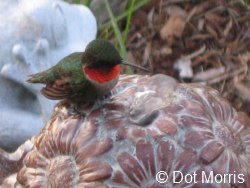

More Info about Bird Baths:
Bird Bath Heater - To place inside an already existing bird bath as a de-icer to keep water from freezing.
Best Bird Guides to help identify birds that visit your bird baths and feeders.
Cardinal in bird bath photo courtesy of ehpien on Flickr.
|
Our Favorite Bird Watching Binoculars, Squirrel-Proof Feeder & Hummingbird Feeder Read Our Reviews: |
||
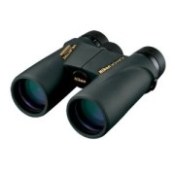
Nikon Monarch M5
Best mid-priced bird watching binoculars. Waterproof, shockproof, multi-coated ED-Glass. |
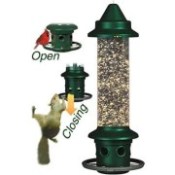
|
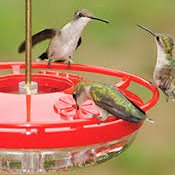
Best Hummingbird Feeder
Drip-Free, Ant-moat, Durable, Easy to Fill and Clean. |
| Click Images or Links To View More Info | ||
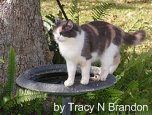 Keeping it elevated will also keep these animals and others from drinking
the water and making it dirty before the birds even get to it. If the bird bath isn't already on a pedestal, raise it up as high off the ground as you can. Also keep it away from thick cover where
predators can hide.
Keeping it elevated will also keep these animals and others from drinking
the water and making it dirty before the birds even get to it. If the bird bath isn't already on a pedestal, raise it up as high off the ground as you can. Also keep it away from thick cover where
predators can hide. 